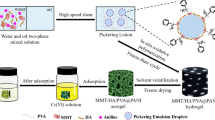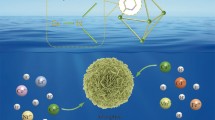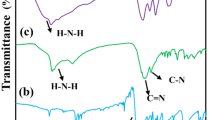Abstract
Metal organic frameworks (MOFs)-based adsorbents for copper ion (Cu2+) generally have the disadvantages of instability in water, low adsorption capacity, and selectivity. Aimed at such problems, we fabricated MOF-199 coated with polyaniline (MOF-199@PANI, core@shell) composite for specific adsorption of Cu2+ in water efficiently. Combined with the characterization by SEM, XRD, and FT-IR, the comprehensively excellent performance probably derived from porous structures of MOF-199, as well as the complexation between Cu2+ and the N atoms of imine moieties in PANI. In addition, the coating process by PANI perfectly protected the MOF skeleton. The isothermal data fitted well to Langmuir isotherm model, of which the calculated adsorption capacity reached 7831.34 mg/g. It was one or two orders of magnitude higher than some other new absorbent for Cu2+ including some carbon-based or organic adsorbents. On the basis of the optimization including pH value, temperature, and ratio of raw materials, the fabricated composite has realized the removal of the spiked Cu2+ in actual fresh water and industrial wastewater samples.











Similar content being viewed by others
Data availability
All data generated or analyzed during this study are included in this article.
References
Alam MA, Wan C, Zhao XQ et al (2015) Enhanced removal of Zn2+ or Cd2+ by the flocculating Chlorella vulgaris JSC-7. J Hazard Mater 289:38–45
Armstrong M, Sirous P, Shan B et al (2018) Prolonged HKUST-1 functionality under extreme hydrothermal conditions by electrospinning polystyrene fibers as a new coating method. Micropor Mesopor Mat 270:34–39
Burtch NC, Jasuja H, Walton KS (2014) Water stability and adsorption in metal-organic frameworks. Chem Rev 114:10575–10612
Canivet J, Fateeva A, Guo YM et al (2014) Water adsorption in MOFs: fundamentals and applications. Chem Soc Rev 43:5594–5617
Cheng K, Wang Y, Tian H et al (2015) Atmospheric emission characteristics and control policies of five precedent-controlled toxic heavy metals from anthropogenic sources in China. Environ Sci Technol 49:1206–1214
Dabrowski A, Hubicki Z, Podkoscielny P et al (2004) Selective removal of the heavy metal ions from waters and industrial wastewaters by ion-exchange method. Chemosphere 56:91–106
DeSantis D, Mason JA, James BD et al (2017) Techno-economic analysis of metal-organic frameworks for hydrogen and natural gas storage. Energ Fuel 31:2024–2032
Ding M, Flaig RW, Jiang HL et al (2019a) Carbon capture and conversion using metal-organic frameworks and MOF-based materials. Chem Soc Rev 48:2783–2828
Ding M, Cai X, Jiang HL (2019b) Improving MOF stability: approaches and applications. Chem Sci 10:10209–10230
Feng MB, Zhang P, Zhou HC et al (2018) Water-stable metal-organic frameworks for aqueous removal of heavy metals and radionuclides: a review. Chemosphere 209:783–800
Fu F, Wang Q (2011) Removal of heavy metal ions from wastewaters: a review. J Environ Manage 92:407–418
Gan X, Zhao H, Chen S et al (2015) Three-dimensional porous HxTiS2 nanosheet-polyaniline nanocomposite electrodes for directly detecting trace Cu(II) ions. Anal Chem 87:5605–5613
Jafari EA, Moradi M, Borhani S et al (2018) Fabrication of hybrid supercapacitor based on rod-like HKUST-1@polyaniline as cathode and reduced graphene oxide as anode. Physica E 99:16–23
Javad NM, Behnam K, Farid M et al (2021) Trace elements in the shoreline and seabed sediments of the southern Caspian Sea: investigation of contamination level, distribution, ecological and human health risks, and elemental partition coefficient. Environ Sci Pollut Res 28:60857–60880
Jeong YC, Seo JW, Kim JH et al (2019) Function-regeneration of non-porous hydrolyzed-MOF-derived materials. Nano Res 12:1921–1930
Kumar P, Pournara A, Kim KH et al (2017) Metal-organic frameworks: challenges and opportunities for ion-exchange/sorption applications. Prog Mater Sci 86:25–74
Liu JC, Culp JT, Natesakhawat S et al (2007) Experimental and theoretical studies of gas adsorption in Cu3(BTC)2: an effective activation procedure. J Phys Chem C 111:9305–9313
Liu Q, Yu H, Zeng F et al (2020) Polyaniline as interface layers promoting the in-situ growth of zeolite imidazole skeleton on regenerated cellulose aerogel for efficient removal of tetracycline. J Colloid Interf Sci 579:119–127
Müller K, Vankova N, Schöttner L et al (2019) Dissolving uptake-hindering surface defects in metal-organic frameworks. Chem Sci 10:153–160
Nguyen LTL, Nguyen TT, Nguyen KD et al (2012) Metal-organic framework MOF-199 as an efficient heterogeneous catalyst for the aza-Michael reaction. Appl Catal A-Gen 425:44–52
Peng Y, Krungleviciute V, Eryazici I et al (2013) Methane storage in metal-organic frameworks: current records, surprise findings, and challenges. J Am Chem Soc 135:11887–11894
Sun DT, Peng L, Reeder WS et al (2018) Rapid, selective heavy metal removal from water by a metal-organic framework/polydopamine composite. ACS Central Sci 4:349–356
Tan B, Zhao HM, Zhang YB et al (2018) Amphiphilic PA-induced three-dimensional graphene macrostructure with enhanced removal of heavy metal ions. J Colloid Interf Sci 512:853–861
Varghese AM, Reddy KSK, Bhoria N et al (2021) Enhancing effect of UV activation of graphene oxide on carbon capture performance of metal-organic framework/graphene oxide hybrid adsorbents. Chem Eng J 420:129–677
Wang Q, Astruc D (2020) State of the art and prospects in metal-organic framework (MOF)-based and MOF-derived nanocatalysis. Chem Rev 120:1438–1511
Xu QX, Yang F, Zhang XP et al (2020) Combining ionic liquids and sodium salts into metal-organic framework for high-performance ionic conduction. Chem Electro Chem 7:183–190
Zhang J, Zhang L, Wei Y et al (2014) A selectively rhodamine-based colorimetric probe for detecting copper(II) ion. Spectrochim Acta A 132:191–197
Zhao FJ, Ma Y, Zhu YG et al (2015) Soil contamination in China: current status and mitigation strategies. Environ Sci Technol 49:750–759
Funding
This work was supported by the National Natural Science Foundation of China (No. 22106070), Jiangsu Postdoctoral Research Funding Program (2021K563C), Open Foundation of Key Laboratory of Industrial Ecology and Environmental Engineering, MOE (KLIEEE-19–06), the Natural Science Foundation of the Jiangsu Higher Education Institutions of China (19KJB610002).
Author information
Authors and Affiliations
Contributions
Mr. Quan Yuan and Mr. Yalun Wang carried out the main experimental work; Dr. Fang Yuan put forward the research idea and took part in the design of experiment, as well as the discussion of results; Miss Shengran Jia took part in the materials characterization; Mr. Haibing Sun took part in the discussion of results; Mr. Xiaokuan Zhang took part in the discussion of results.
Corresponding author
Ethics declarations
Ethical approval
Not applicable.
Consent to participate
Not applicable.
Consent to publish
Not applicable.
Competing interests
The authors declare no competing interests.
Additional information
Responsible Editor: Angeles Blanco
Publisher's note
Springer Nature remains neutral with regard to jurisdictional claims in published maps and institutional affiliations.
Quan Yuan and Yalun Wang are co-first authors. They contribute equally to the article.
Supplementary Information
Below is the link to the electronic supplementary material.
Rights and permissions
About this article
Cite this article
Yuan, Q., Wang, Y., Yuan, F. et al. Water-stable metal organic framework-199@polyaniline with high-performance removal of copper II. Environ Sci Pollut Res 29, 44883–44892 (2022). https://doi.org/10.1007/s11356-022-19047-8
Received:
Accepted:
Published:
Issue Date:
DOI: https://doi.org/10.1007/s11356-022-19047-8




